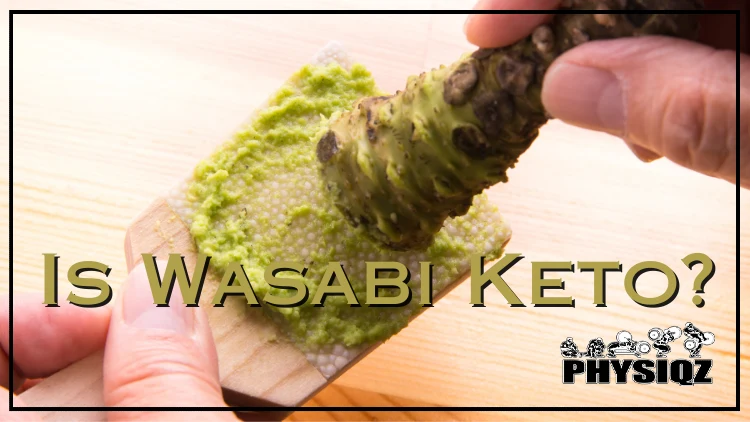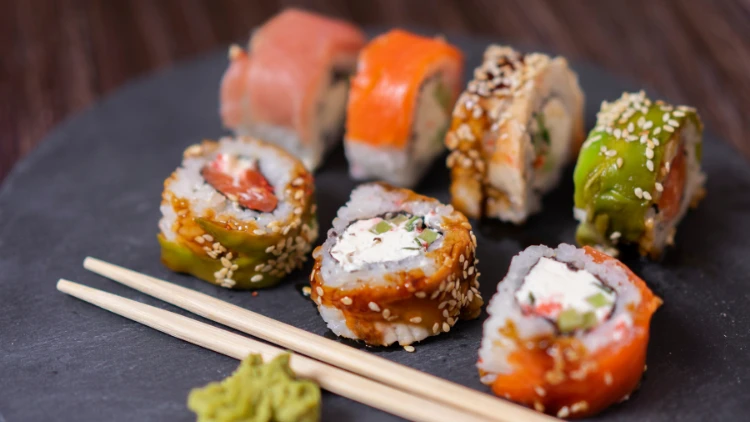
Wasabi, including wasabi peas, powder, and paste, offers various impressive health benefits. Despite having a high carbohydrate content per tablespoon serving, wasabi can be enjoyed in moderation due to its pungent flavor.
Which goes to say, wasabi is keto due to the small serving sized and so long as you follow the less is more rule (eating small quantities), then you’re in the clear keto wise.
That being said, we’ll cover the exact number of carbs in normal wasabi — from peas, powder and paste — as well as the array of health benefits.
Carbohydrate Content of Wasabi
Wasabi paste has approximately 7 grams of carbohydrates per 1 tablespoon. When following a keto diet, someone typically aims to limit their carb intake to about 20-50 grams per day.1
Therefore, a good rule of thumb when considering whether to include wasabi in a keto diet is that less is more. With a serving size of 1 tablespoon, wasabi has too many carbs to be suitable for a keto diet so moderation is key here.

Source: VisionPic.net via Canva.com2
It’s important to remember that wasabi does have such a strong flavor so a little amount can go a long way.
Whereas 1 tablespoon of wasabi has 7 grams of carbs, 1 teaspoon only has 2 carbs per serving which is a much more reasonable amount to be allowed on keto.
What Is the Nutritional Content of Wasabi?
Below is the nutrition breakdown for 1 tablespoon of wasabi paste as per the U.S. Department of Agriculture.3 Later in the article check out the full breakdown of 1 teaspoon of wasabi paste.
- Calories: 47
- Fat: 1.7 grams
- Sodium: 542 mg
- Carbohydrates: 7.4 grams
- Fiber: 0.98 grams
- Net Carbs: 6.42 grams
- Protein: 0.4 grams
Keto Suitability of Wasabi
Wasabi can be keto-friendly depending on the serving size. For instance, one tablespoon of wasabi paste contains 7 grams of carbohydrates, which may be too much for a keto diet.
While there are different variations of a keto diet, the basic keto diet includes a macro breakdown of about 55-60% fat, 30-35% protein, and 5-10% carbohydrates, which can be between 20-50 grams of carbohydrates each day.4 Thus, 7 grams of carbohydrates for 1 tablespoon of a condiment would be too much.
In order for wasabi to be keto-approved moderation is key and the “less is more” rule must be followed. This could be easily achieved due to the strong flavor wasabi paste has so a small quantity could go a long way.
All in all, a tablespoon of wasabi is too much for a keto diet, while 1 teaspoon of wasabi only has 2 grams of carbs so small quantities of wasabi can be eaten on a keto diet.
What Is Wasabi & How Is It Made?
Wasabi, a fiery green condiment commonly accompanying sushi in Japanese dining establishments that serve sake, so understanding if sake aligns with a keto diet can be advantageous. Real wasabi is made from finely grating the rhizome, or underground stem part of a plant of the mustard family called the brassicaceae.
It is interesting to know that wasabi found outside of Japan is most likely not real wasabi because the plant is very expensive and difficult to find as it is only native to Japan.
This plant actually grows wild in Japan but is difficult to grow because it requires being submerged in moving water, a very rare farming structure. Furthermore, it is very sensitive to environmental changes and humidity, so overall this plant is very challenging to grow outside of its native Japan.
Wasabi made in western cultures is most often made from a different plant in the mustard family, horseradish. Typically imitation wasabi will sometimes include a very small amount of real wasabi, ranging between 1 and 3%.
Interestingly, because of this, most people outside of Japan have most likely not tasted real wasabi.
What Types of Wasabi Are There? Powder vs Paste
Wasabi can come in powder and paste form. Wasabi powder is made by drying the wasabi plant and grinding it into a fine powder.
It can be more versatile as it can be sprinkled on fish, mixed with breadcrumbs for a spicy crusted chicken breast, and more. Additionally, water can be added to the powder to make wasabi paste.
Wasabi paste may be the more recognizable product as it is almost always served with sushi. Believe it or not, wasabi paste can also be used in a lot of different ways, such as being added to dipping sauces such as mayonnaise, butter, or hummus and used for marinating meats.
Some ice cream shops even offer wasabi ice cream!

Source: Umnat Seebuaphan’s Images via Canva.com5
Interestingly, most powdered and pasted wasabi sold is not pure, real wasabi and instead made with horseradish. It can be fairly easy to spot the difference between real and fake wasabi based on texture.
If the wasabi is thick and pasty this is a sign it is not real and is made from horseradish. Real wasabi will have a grated and gritty texture instead of a smooth one.
One final common wasabi product consumers can find are wasabi peas. These are very popular snacks in Japan that are found all over.
They are dried and roasted green peas seasoned with oil, salt, sugar, and wasabi. These are a great, healthier option compared to potato chips because they are peas but unfortunately, they should be avoided while on a keto diet unless consumed in a very small amount because they do have a significant number of carbs.
Pure wasabi powder and wasabi peas do have a different nutritional breakdown compared to wasabi paste.
Here is the breakdown for 1 teaspoon of 100% pure wasabi powder compared with 1 teaspoon of wasabi paste and 1 serving size of wasabi peas which is 1 ounce or about 55 wasabi peas.
100% Real Wasabi Powder Nutrition Facts (1 tsp)
- Calories:10
- Fat:0 grams
- Carbs: 3 grams
- Fiber: 0 grams
- Net Carbs: 3 grams
- Sodium: 55 grams
- Sugar: 0 grams
- Protein: 0 grams
Wasabi Paste Nutrition Facts (1 tsp)
- Calories: 15
- Fat:<1 gram
- Carbs:2 grams
- Fiber:1 gram
- Net Carbs: 1 gram
- Sodium:180 grams
- Sugar:0 grams
- Protein:0 grams
Wasabi Peas Nutrition Facts (1 ounce- 55 pieces)
- Calories: 130
- Fat: 4 grams
- Carbs: 18 grams
- Fiber: 1 gram
- Net Carbs: 17 grams
- Sodium: 85 grams
- Sugar: 4 grams
- Protein: 4 grams
What Are the Health Benefits of Wasabi? Is Wasabi Good for You?
When considering whether wasabi is keto-friendly, you might also be curious about its health benefits. Here are five surprisingly amazing health benefits of wasabi.
- Inhibiting AA: Acrylamide (AA) is formed through some cooked foods and has been linked with damaging DNA and has the potential for causing cancer.6 Research has shown wasabi roots and leaves are effective ingredients to help inhibit the genotoxicity of AA.7
- Improve Heart Health: Research has shown the active component, allyl isothiocyanate (AITC) in wasabi can improve cholesterol and high blood pressure.8
- Antibacterial Effects: While more research is needed in this area, initial studies have shown that the AITC found in wasabi has a strong antibacterial property and has been shown to control the common foodborne outbreaks that cause food poisoning, E coli and S. aureus.9
- Potential Weight Loss: Again, more research is needed as the primary studies focusing on weight and fat loss has been done with mice, but the initial research has shown that wasabi plant leaves have the potential to suppress the growth and formation of fat.10
- May Prevent Weight Gain: Research on mice has shown that wasabi had the ability to prevent weight gain while fed a high-fat diet.11 Consider exploring how wasabi may offer insights into addressing concerns related to upper belly fat reduction.
Because pure wasabi is more expensive and the plant is difficult to grow, most wasabi contains horseradish as well. Horseradish does contain isothiocyanate (ITC) which is one of the compounds found in wasabi that has been associated with many health benefits, so the above benefits could still be present even if pure wasabi is not being consumed.
Recipes & Ways To Use Wasabi
While wasabi may be best known for being served with sushi, wasabi is more versatile and can be used in a variety of different ways. Here are 3 different and unique ways to incorporate wasabi into a meal plan.
- Adding Spice to Condiments: Wasabi can be a great addition to add spice to mayonnaise, butter, hummus, guacamole, and other condiments.
- Wasabi Mashed Potatoes: It’s amazing how less is more applies often when discussing wasabi. One pinch of wasabi powder or a little bit of paste in mashed potatoes can truly enhance the dish and creates a gentle heat.
- Marinade: Wasabi powder can be a great tool in marinating a variety of different types of meats. While wasabi can be a great addition to any meat, steak, and trout do pair well.
While pure, 100% wasabi may be rare to come by, wasabi powder and paste come with some impressive health benefits and can be enjoyed in a variety of different ways.
When wondering if wasabi is keto-friendly, it’s important to remember that less is more; moderation is key.
Frequently Asked Questions
Are Wasabi Peas Suitable for a Keto Diet?
Unfortunately, wasabi peas should be avoided while on keto as 1 serving size which is 1 ounce or 55 peas boasts 17 grams of net carbohydrates. It would be possible to sneak these into a keto diet if a small amount is enjoyed though.
Are Wasabi-Flavored Almonds Suitable for a Keto Diet?
1 serving size of wasabi-flavored almonds is 1 ounce or about 28 nuts. There are 3 grams of net carbs per serving so these would be something that could fit into a keto diet, although moderation is key and it is essential to stick to one serving size or less.
How Much Wasabi Can I Eat While Following a Keto Diet?
Wasabi does have a significant number of carbs, so while eating wasabi may be compatible with a keto diet, intuitive eating could be helpful, and remember that moderation is crucial. One teaspoon of wasabi has only 1 net carb, making it a good serving size due to its strong flavor—a little goes a long way.
Is Wasabi Good for Weight Loss?
Initial research on rats has shown properties in wasabi have the potential to reduce weight and fat and prevent weight gain. Additionally, due to the low carb content, wasabi enjoyed in moderation could be a good option when looking for a spicy condiment and working towards weight loss solutions.
References
1Batch, J. T., Lamsal, S. P., Adkins, M., Sultan, S., & Ramirez, M. N. (2020). Advantages and Disadvantages of the Ketogenic Diet: A Review Article. Cureus, 12(8). <https://www.ncbi.nlm.nih.gov/pmc/articles/PMC7480775/>
2VisionPic.net. “Sushi Rolls.” Canva. Accessed 9 April 2023. <https://www.canva.com/photos/MADyRCGoBEI-sushi-rolls/>
3U.S. Department of Agriculture. (2023). Wasabi Paste. FoodData Central. <https://fdc.nal.usda.gov/fdc-app.html#/food-details/1103692/nutrients>
4Masood, W., Annamaraju, P., & Uppaluri, K. R. (2022). Ketogenic Diet. StatPearlls [Internet] <https://www.ncbi.nlm.nih.gov/books/NBK499830/>
5Umnat Seebuaphan’s Images. “man hand stack block woods with science design.” Canva. Accessed 9 April 2023. <https://www.canva.com/photos/MAEh73h_XlQ-man-s-hand-stack-block-woods-with-science-design/>
6National Cancer Institute. (2023). Acrylamide and Cancer Risk. About Cancer. <https://www.cancer.gov/about-cancer/causes-prevention/risk/diet/acrylamide-fact-sheet>
7Shimamura, Y., Lio, M., Urahira, T., & Masuda, S. (2017). Inhibitory effects of Japanese horseradish (Wasabia japonica) on the formation and genotoxicity of a potent carcinogen, acrylamide. J Sci Food Agric, 97(8). <https://pubmed.ncbi.nlm.nih.gov/27670634/>
8Thomaz, F. S., Altemani, F., Panchal, S. K., Worrall, S., & Nitert, M. D. (2021). The influence of wasabi on the gut microbiota of high-carbohydrate, high-fat diet-induced hypertensive Wistar rats. J Hum Hypertens, 35(2), 170-180. <https://pubmed.ncbi.nlm.nih.gov/32457512/>
9Lu, Z., Dockery, C. R., Crosby, M., Chavarria, K., Patterson, B., & Giedd, M. (2016). Antibacterial Activities of Wasabi against Escherichia coli O157:H7 and Staphylococcus aureus. Front Microbiol. <https://www.ncbi.nlm.nih.gov/pmc/articles/PMC5030237/>
10Kim, Y.-J., Lee, D.-H., Ahn, J., Chung, W.-J., Jang, Y. Y., Seong, K.-S., Moon, J.-H., Ha, T. Y., & Jung, C. H. (2015). Pharmacokinetics, Tissue Distribution, and Anti-Lipogenic/Adipogenic Effects of Allyl-Isothiocyanate Metabolites. PLoS One, 10(8). <https://pubmed.ncbi.nlm.nih.gov/26317351/>
11Yamasaki, M., Ogawa, T., Wang, L., Katsube, T., Yamasaki, Y., Sun, X., & Shiwaku, K. (2013). Anti-obesity effects of hot water extract from Wasabi (Wasabia japonica Matsum.) leaves in mice fed high-fat diets. Nutr Res Pract, 7(4), 267-272. <https://pubmed.ncbi.nlm.nih.gov/23964313/>